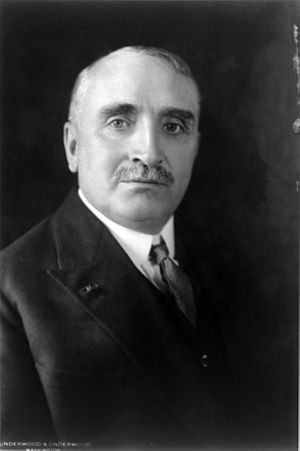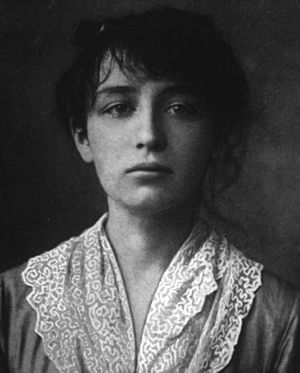Paul Claudel facts for kids
Quick facts for kids
Paul Claudel
|
|
|---|---|
 |
|
| Born | 6 August 1868 Villeneuve-sur-Fère, France |
| Died | 23 February 1955 (aged 86) Paris, France |
| Language | French |
| Education | Lycée Louis-le-Grand |
| Alma mater | Paris Institute of Political Studies |
| Genre | Verse drama |
| Spouse | Reine Sainte-Marie Perrin |
| Relatives | Camille Claudel (sister) |
| Signature | |
Paul Claudel (born August 6, 1868 – died February 23, 1955) was a famous French writer and diplomat. He wrote many poems and plays. He was also the younger brother of the well-known sculptor Camille Claudel. Paul Claudel is especially remembered for his "verse dramas," which are plays written in poetic language. These plays often showed his strong Catholic faith.
Contents
Early Life and Faith
Paul Claudel was born in Villeneuve-sur-Fère, a small town in France. His family were farmers and government workers. When he was 13, his family moved to Paris. He then studied at the Lycée Louis-le-Grand, a famous school.
When he was a teenager, Paul Claudel did not believe in God. But on Christmas Day in 1886, something important happened. He was listening to a choir sing in the Notre Dame Cathedral in Paris. He later wrote that "in an instant, my heart was touched, and I believed." From that moment on, he was a devoted Catholic for the rest of his life. He also discovered the poetry of Arthur Rimbaud, which inspired him. He wanted to use poetry to show the amazing plan of creation.
Claudel also studied at the Paris Institute of Political Studies. This school helped him prepare for a career in government.
A Career in Diplomacy
Paul Claudel thought about becoming a monk, but he chose a different path. He decided to join the French diplomatic service. This meant he would represent France in other countries. He worked as a diplomat from 1893 to 1936.
His first job was as a vice-consul in New York City in 1893. Later that year, he moved to Boston. From 1895 to 1909, he served as a French consul in China. He worked in cities like Shanghai and Fuzhou. During this time, he took a break in France and considered joining a religious order, but he didn't.
Claudel was part of a group of writers who had support from Philippe Berthelot, a friend from the Foreign Ministry. Because he was a diplomat, Claudel first published his writings without his real name. This was because he needed permission from the government to publish. In 1909, a group of writers wanted to publish his work under his own name. He sent them a poem, and it was published. This led to some debate, but it also started a long partnership between Claudel and the Nouvelle Revue Française, a famous literary magazine.
He wrote a lot about China, and his book Connaissance de l'Est was published in 1914. After China, he worked in Europe. He was in Prague, Frankfurt, and Hamburg before World War I. During the war, he worked in Rome and then in Rio de Janeiro, Brazil. In Brazil, he helped make sure food supplies reached France. A famous composer named Darius Milhaud was his secretary there. Milhaud even wrote music for some of Claudel's plays.
Later, Claudel became an ambassador. He served in Tokyo (1921–1927), Washington, D.C. (1928–1933), and Brussels (1933–1936). He was a very important diplomat for France.
Later Years
In 1935, Paul Claudel retired from his diplomatic career. He moved to his home, a château in Brangues, France, which he had bought in 1927. He still spent his winters in Paris.
During World War II, after France was defeated in 1940, Claudel went to Algeria. He offered to help Free France, a government in exile that fought against Nazi Germany. When he didn't get a response, he returned to Brangues. He supported the Vichy government, which ruled part of France during the war. However, he disagreed with their policy of working with Nazi Germany.
Claudel helped his daughter-in-law's brother-in-law, who was arrested by the Vichy government. He also wrote a letter in 1941 against the "Statut des Juifs," which were laws that harmed Jewish people. Because of this, the Vichy authorities searched his house and watched him closely.
In 1946, Paul Claudel was chosen to be a member of the Académie française. This is a very respected group that protects the French language. He had been nominated for the Nobel Prize in Literature several times.
His Writings
Paul Claudel looked up to the poet Stéphane Mallarmé as his teacher. Claudel believed that the world itself was like a religious text that revealed God's plan. He didn't use traditional poetry rules. Instead, he created his own style called the verset claudelien, which was a type of free verse.
Some of his most famous plays include:
- Le Partage de Midi ("The Break of Noon," 1906)
- L'Annonce faite à Marie ("The Tidings Brought to Mary," 1910) – This play is about sacrifice and a young medieval French woman who gets leprosy.
- Le Soulier de Satin ("The Satin Slipper," 1931) – This long play explores human and divine love. It is set in the Spanish Empire during its "Golden Age." This play was performed at the Comédie-Française, a famous French theater, in 1943.
- Jeanne d'Arc au Bûcher ("Joan of Arc at the Stake," 1939) – This was an oratorio, a musical work, with music by Arthur Honegger.
Claudel's plays often took place in distant, romantic settings, like medieval France or 16th-century South America. They often featured strong, passionate love stories. Because his plays were complex and large, it took a while for audiences to fully appreciate them. His last play, L'Histoire de Tobie et de Sara, was first performed in 1947.
Besides his plays, Claudel also wrote lyric poetry. A well-known example is his Cinq Grandes Odes (Five Great Odes) from 1907.
Views and Legacy
Paul Claudel held traditional, conservative views. While some people at the time had negative views towards Jewish people, Claudel strongly condemned Nazism as "demonic" as early as 1930. He also called the Nuremberg Laws, which took away rights from Jewish people, "abominable and stupid." He wrote an open letter to the World Jewish Conference in 1935, speaking out against these laws.
He supported Charles de Gaulle and the Free French forces during World War II. When Paris was freed in 1944, he wrote a poem celebrating de Gaulle's victory.
The British poet W. H. Auden recognized Claudel's importance in his poem "In Memory of W. B. Yeats." George Steiner, a famous writer, called Claudel one of the three "masters of drama" in the 20th century.
Family Life
Paul Claudel married Reine Sainte-Marie Perrin in 1906. She was the daughter of a famous architect from Lyon. They had two sons and three daughters.
His Sister, Camille
Paul Claudel's older sister was Camille Claudel, a very talented sculptor. Sadly, in March 1913, Paul Claudel had his sister Camille admitted to a psychiatric hospital. She stayed there for the last 30 years of her life. Paul visited her only seven times during those 30 years. Records show that while she had some mental health challenges, she was often clear-headed, especially when she was working on her art. Doctors even tried to tell the family that she didn't need to be in the institution, but she remained there.
Camille's story has been told in books and movies. For example, the novel La Robe bleue by Michèle Desbordes is about her. There is also a song called "La soeur de Paul" ("Paul's sister") by Jean-Charles de Castelbajac.
See also
 In Spanish: Paul Claudel para niños
In Spanish: Paul Claudel para niños
- L'Histoire de Tobie et de Sara
- L'Annonce faite à Marie, a film based on his play
- Lycée Claudel, a French school in Canada named after him
- Camille Claudel, a 1988 film about his sister
- Camille Claudel 1915, a 2013 film about his sister


